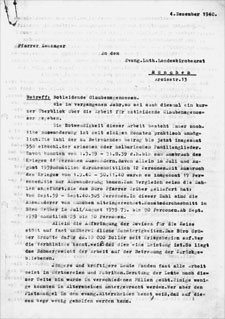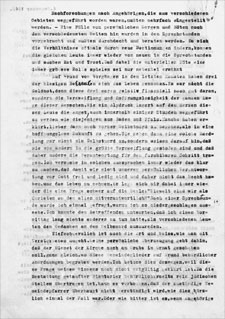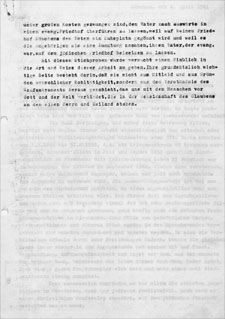Aid Agencies for “Fellow Believers in Distress”
From the onset of National Socialist rule, Protestant laity and clergy went against the churchgoing mainstream and called upon their church again and again to protest racial policy. Police actions, fixation on internal conflict and its own partial agreement with the regime’s policies prevented the church from coming to the aid of victims of racial persecution. Even the Bavarian regional church kept silent. The Confessing Church’s leadership could not be moved to take action on behalf of Protestant victims of racial persecution until May of 1938. Heinrich Grüber (1891–1975), a pastor in Berlin, was supposed to provide emigrants assistance.
At the end of September of 1938, Grüber requested support from Bishop Theophil Wurm (1868–1953) in Stuttgart and Bishop Hans Meiser (1881–1956) in Munich. Just two days after Grüber’s request, the regional consistory resolved to support “fellow believers in distress” –wording that emphasized Christian fellowship rather than ideologically defined racial differences – and their families. Given its prior passiveness, the regional church had made a decision of unexpected clarity.
First, Friedrich Hofmann (1904–1965), the first chaplain of the Inner Mission in Munich, was entrusted with the care of racially persecuted Protestants. He did not harbor any grand illusions about the effectiveness of this work.
The church government quickly reached an agreement about the funding of the aid work. Up to RM 10,000 a year was budgeted even though the actual form of the work was still unclear. The regional church not only generously supported its own aid agencies until 1945, long after the general ban on emigration of October of 1941, but also allocated a remarkable amount to Pastor Grüber’s Office.
Since the heavily increased need for support grew after the November Pogrom of 1938 was more than Hofmann could handle alone, he asked the regional bishop to appoint a full-time employee. Parallel to these events, the regional church had to deal with the situation of its so-called non-Aryan pastors, required to submit certificates of Aryan descent by the new Bavarian education act. One of them was Johannes Zwanzger (1905–1999) from Thüngen, who had been summoned to Munich on January 1, 1939 to serve as a pastor and as Hofmann’s assistant for the Inner Mission. The second position with the Inner Mission in Nuremberg was filled by Pastor Hans Werner Jordan (1908–1978), a person of mixed blood of the first degree according to Nazi racial laws. His family had already suffered severely from racial persecution.
In order to allay any suspicion of illegality, the authorities were notified of the existence of the aid agencies when they started providing care in January of 1939. This move did nothing more than attract the attention of the Gestapo in Munich and Nuremberg.
Jordan and Zwanzger routinely reported to their superiors about their work. Precise information on the number of people in need and their work’s success rate thus reached those in charge. They were also meticulously informed of the consequences for victims of Nazi racial policy. Moreover, Zwanzger regularly apprised Bishop Meiser of the situation in face-to-face conversations. Certain cases induced Meiser to consider approaching Reichsmarschall Hermann Göring (1893–1946) in mid-1941.
The circle of people seeking aid came from all walks of life. Admittedly, the people seeking aid were usually far too old to interest host countries. Jordan and Zwanzger additionally had to deal with more than just emigration regulations, which growing increasingly restrictive, and government demands for money. An equally major challenge was the potential host countries’ restrictive immigration policy even for ideally qualified individuals.
In addition to providing advice on everyday problems and impartially cultivating contacts, the two pastors provided aid that thwarted the state sanctioned exclusion, disenfranchisement and isolation of so-called non-Aryans. Their work entailed the following overlapping and successive activities:
1.) Their principal job was to care for people intending to emigrate, i.e. victims of racial persecution and spouses and children wanting to follow a spouse, parent or child who had been forced to flee or already emigrated, and raising the money for travel or procuring the guarantees required in the host country. People desiring to leave the country turned to the aid agencies directly or were referred, primarily by Pastor Grüber's Office, to the authorities responsible for them. Zwanzger and Jordan used their diverse contacts to embassies and consulates, aid organizations and private individuals to help such people hunt for jobs in potential host countries. The bureaucratic obstacles and harassment that cropped up again and again compelled them to perform organizational feats when procuring documents, for instance.
2.) Hunting for a job was frequently the second phase of care when emigration had come to naught.
3.) They provided welfare and assistance finding residences and contacted authorities or families in the event of job loss, old age, illness or imprisonment.
Meiser was especially concerned about housing for the elderly. He therefore instructed Zwanzger to make preparations for the establishment of a home for aged victims of racial persecution. Pastor Friedrich Langenfass (1880–1965) had already proposed in January of 1939 that the regional church buy a building for racially persecuted Christians who became homeless. Ideas to accommodate people seeking aid in Inner Mission homes, which had been proposed at the same time, proved to be unfeasible.
Parish pastors and the Inner Mission Associations played an important role in aiding racially persecuted Christians in Bavaria. They connected victims of persecution with aid agencies or established initial contacts, provided character references and ministered locally.
Only fragmentary figures on the number of recipients of aid and emigrants are available. Sixty-five of the over 530 recipients of aid in Munich had left Germany by the end of November of 1940. Not enough records survive for a comparable figure for the aid agency in Nuremberg
Source / title
- © 1: Landeskirchliches Archiv Nürnberg, Fotosammlung; 2: Landeskirchliches Archiv Nürnberg, Vereine II, XIV, Nr. 1




